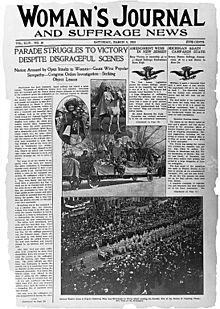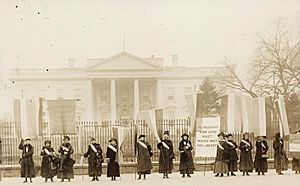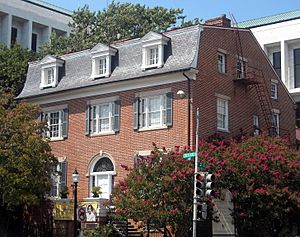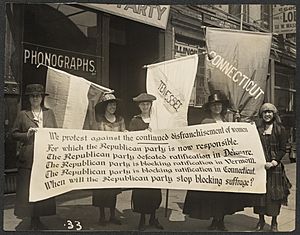National Woman's Party facts for kids
 |
|
| Successor | Alice Paul Institute |
|---|---|
| Formation | June 5, 1916 |
| Dissolved | January 1, 2021 |
| Purpose | "To secure an amendment to the United States Constitution enfranchising women" and to pass the ERA |
| Headquarters | Washington, D.C., U.S. |
|
Key people
|
Alice Paul, Lucy Burns, Mabel Vernon, Anne Henrietta Martin |
| Website | https://www.alicepaul.org/ |
|
Formerly called
|
Congressional Union for Woman Suffrage |
The National Woman's Party (NWP) was an American political group. It was formed in 1916 to fight for women's suffrage, which means women's right to vote. After women gained the right to vote in 1920, the NWP worked on other important issues. These included the Equal Rights Amendment, which aimed for equal rights for all people, regardless of gender.
The most important leader of the National Woman's Party was Alice Paul. Their most famous action was the Silent Sentinels protest. This was a long protest outside the White House from 1917 to 1919.
As of January 1, 2021, the NWP stopped working as its own group. Its name and rights were given to the Alice Paul Institute. This institute will continue to share the history and ideas of the NWP.
Contents
What Was the National Woman's Party?
The National Woman's Party grew out of another group called the Congressional Union for Woman Suffrage. Alice Paul and Lucy Burns started this group in 1913. They wanted to win the right to vote for women.
The NWP was different from a larger group called the National American Woman Suffrage Association (NAWSA). NAWSA tried to get women the right to vote state by state. The NWP, however, focused on passing a special change to the U.S. Constitution. This change would give women the right to vote all across the country.
How the NWP Started
Alice Paul learned a lot about fighting for women's rights in England. She worked with a group there led by Emmeline Pankhurst. While in England, Alice Paul met Lucy Burns, who later helped start the NWP.
When Paul came back to the United States, she used new ways to protest. These methods were called civil disobedience. This means peacefully refusing to obey certain laws or demands as a way of protesting. For example, some British protesters would cause trouble. But Paul focused on peaceful actions in the U.S.
The NWP believed it was wrong for the U.S. to fight for democracy in Europe during World War I. They felt it was unfair when women in the U.S. did not have the right to vote. Many countries in Europe were already giving women the right to vote.
In 1913, Alice Paul and Lucy Burns organized a huge parade in Washington, D.C. This was the day before President Woodrow Wilson's inauguration. Thousands of women marched to show their strength. Inez Milholland led the parade on a white horse. She became a symbol for the movement.
However, there was a problem with this parade. Black women were not allowed to march with white women. They had to march at the back. Alice Paul did this to keep the support of women from the Southern states. The parade became chaotic because of angry crowds and little help from the police.
After this event, Paul and Burns started the Congressional Union for Woman Suffrage. This group later became the NWP. They split from NAWSA because they wanted to focus on a national amendment. They felt NAWSA's approach of working state by state was too slow.
Protesting President Wilson

The NWP decided not to support any political candidate during elections. Instead, they focused on President Woodrow Wilson and his party, the Democrats. They criticized them for not passing a constitutional amendment for women's suffrage.
In 1918, Alice Paul led a campaign to boycott Democrats. This meant asking people not to vote for them. This happened even if a Democrat supported women's suffrage. The NWP's actions helped the Republican party gain more power in the House of Representatives.
The NWP kept its main focus on women getting the right to vote. They did not take a side on World War I. This was different from NAWSA, which fully supported the war. Because of this, many people who wanted peace joined the NWP.
Protesting at the White House

The NWP continued to protest President Wilson's actions. They felt it was wrong for him to promote democracy in other countries while women in the U.S. could not vote. These protests were controversial, especially during wartime. Other suffrage groups like NAWSA supported the war effort.
The NWP's protests were called the "Silent Sentinels". They stood outside the White House every day from January 1917 to June 1919. They held banners that reminded Wilson of his unfair stance.
At first, the police allowed the protests. But after the U.S. entered the war in 1917, the women were arrested for blocking traffic. They were treated like regular criminals, but they said they were political prisoners. To show their dedication, they refused to pay fines and chose to go to prison.
Many NWP members went on hunger strikes in prison. Some, like Lucy Burns and Alice Paul, were force-fed by the jail staff. This was a very harsh treatment. The women were also forced to work and were often mistreated.
Their stories were shared with the press and in The Suffragist, their newspaper. Doris Stevens, an NWP member, wrote about her terrible experiences in her book Jailed for Freedom. This publicity helped their cause. It made President Wilson look bad, especially since he was trying to be a leader in human rights around the world.
President Wilson eventually changed his mind about women's suffrage. He had supported women voting at the state level. But he had not supported a national amendment because his party was divided. The NWP's strong protests and other actions helped convince him. In January 1918, Wilson asked the House of Representatives to pass the bill. The bill passed the House but was delayed in the Senate until 1919. Finally, it was sent to the states to be approved. Many historians believe the NWP's campaign was key to passing the Nineteenth Amendment.
Fighting for Equal Rights
The NWP played a big part in getting the Nineteenth Amendment passed in 1920. This amendment gave U.S. women the right to vote. After this, Alice Paul focused on the Equal Rights Amendment (ERA). She believed the ERA was needed for women to have true equality.
In 1923, the NWP started publishing a magazine called Equal Rights. This magazine aimed to educate both women and men about women's rights.
The ERA stated:
Men and women shall have equal rights throughout the United States and every place subject to its jurisdiction.
The NWP did not support laws that were meant to "protect" women in the workplace. They argued these laws actually lowered women's pay and stopped them from getting certain jobs. However, the NWP did support working women. Alice Paul organized many meetings for working-class women to meet with President Wilson.
After 1920, the National Woman's Party wrote over 600 pieces of legislation to fight for women's equality. More than 300 of these became law. The NWP also kept pushing for the ERA. They lobbied Congress for many years to get the amendment introduced.
Congress passed the ERA in 1972, and many states approved it. But in 1982, a group of conservatives stopped it, and it never became law. However, in 1964, the NWP helped add "sex" to the Civil Rights Act of 1964. This law made it illegal to discriminate based on sex. This achieved some of the NWP's goals.
Civil Rights Act of 1964
In 1963, a law called the Equal Pay Act of 1963 was passed. This law made it illegal to pay men and women differently for the same job.
The idea to ban discrimination based on sex was added to the Civil Rights Act of 1964 by a politician named Howard W. Smith. He was a conservative who opposed civil rights for Black people. But he supported equal rights for white women.
Historians wonder why Smith added "sex" to the bill. Some think he wanted to make the bill fail. Others believe he truly supported women's rights. Smith had worked with the National Woman's Party and Alice Paul for many years. They wanted to include sex as a protected group in civil rights laws.
Another politician, Martha Griffiths, argued that the new law would protect Black women but not white women. She also said that laws meant to "protect" women from certain jobs actually kept men in those jobs. The amendment passed with votes from Republicans and Southern Democrats. The final law passed with votes from Republicans and Northern Democrats. Pauli Murray was also important in getting "sex" included in the Civil Rights Act. This part of the law, called Title VII, has greatly helped women as a group.
Legacy of the NWP

The Nineteenth Amendment, which gave women the right to vote, became law in 1920. However, many African American women and men in the Southern states still could not vote because of unfair laws. They did not gain full voting rights until the Voting Rights Act of 1965.
Today, the National Woman's Party is an educational organization. It works to keep and share the history and documents of the original NWP. The NWP operates from the Belmont–Paul Women's Equality National Monument in Washington, D.C. Here, you can see items from their collection.
The NWP's history is complex. While Alice Paul and the NWP were key to passing the Nineteenth Amendment, they did not help Black women gain the right to vote. To keep support from Southern members, Paul avoided talking about race in the South. Her main focus was the ERA, so she did not fight against the unfair Jim Crow Laws that stopped Black women from voting.
Historians note that the NWP stayed focused on one goal for women. It was a group that worked directly with politicians and presidents to get its message out.
In 1972, Congress passed the ERA, and many states approved it. But in 1982, a group led by Phyllis Schlafly stopped it, and it never became law.
Notable Members
Here are some of the important women who were part of the National Woman's Party:
- Edith Ainge (1873-1948), treasurer of the NWP
- Nina E. Allender, political cartoonist
- Caroline Lexow Babcock
- Abby Scott Baker
- Mary Ritter Beard
- Alva Belmont
- Harriot Stanton Blatch
- Lucy Burns, co-founder
- Marion Cothren
- Dorothy Day
- Amelia Earhart
- Crystal Eastman
- Julia Emory
- Sara Bard Field
- Phoebe Hearst
- Alison Turnbull Hopkins
- Inez Haynes Irwin
- Edna Buckman Kearns (1881-1934), suffrage activist
- Anne Martin
- Nell Mercer
- Inez Milholland
- Vida Milholland
- Alice Paul, main leader and co-founder
- Florence Kenyon Hayden Rector
- Rebecca Hourwich Reyher
- Caroline Spencer
- Doris Stevens, author of Jailed for Freedom
- Phyllis Terrell
- Mabel Vernon
- Agnes E. Wells
- Evelyn Wotherspoon Wainwright
- Rose Winslow
- Margaret Fay Whittemore
- Emma Wold
- Clara Snell Wolfe
- Maud Younger (1870-1936), suffragist and labor activist
Images for kids
-
Portrait of Alice Paul, 1915
-
Lucy Burns, Vice Chairman Congressional Union, 1913
-
Nina Allender, political cartoonist for The Suffragist
-
Doris Stevens, author of Jailed for Freedom
See also
 In Spanish: Partido Nacional de la Mujer (Estados Unidos) para niños
In Spanish: Partido Nacional de la Mujer (Estados Unidos) para niños











